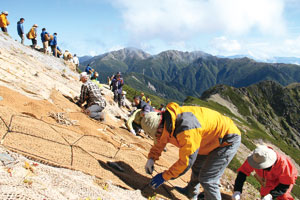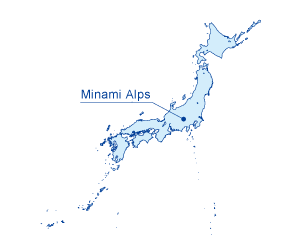National Parks of Japan
Impact of and countermeasures against Japanese deer on alpine and subalpine areas
A case in the Minami Alps National Park of Japan

Laying anti-erosion mats on the slopes of Mt. Shiomi-dake

In the Minami Alps National Park, mountains are higher than 3000m and there is abundant nature and beautiful scenery. Its main alpine and subalpine areas have abundance of species including grouse and callianthemum hondoense which are relict, endemic and rare and of which southernmost habitat is the Minami Alps. The region, therefore, is deemed important from a biodiversity conservation viewpoint.
However, since the end of the 1990s, damages to the alpine and subalpine vegetation began to be reported, and in the next 10 years the effects rapidly spread, creating problems like simplification and decline of vegetation as well as soil erosion.
The deer in the Minami Alps National Park migrate between the high mountains of summer and the snowy mountain bases at winter. To keep their numbers down, deer are culled in their wintering zones and migratory trails, as well as in the summer high mountains. At the same time, widespread measures, such as soil erosion prevention mats and vegetation protection measures such as deer proof fences are put into place.
These measures are carried forward in conjunction with the national and regional government bodies, nonprofits and volunteers.


